Text

CONTENDER 1: BRAZILIAN TREEHOPPER!
Bocydium globulare is a species of treehopper native to South America. They feed on leaf matter and sap. The round, bulbous appendages on top of their thoraxes have a purpose yet to be determined by scientists, but it's theorized that they're used in predator deterrence.
CONTENDER 2: GIANT WETA!
Giant wētā, Deinacrida spp., are a group of insects endemic to New Zealand. These giant, flightless crickets are some of the heaviest insects in the world, with some known organisms weighing more than seventy grams, more than an average sparrow. The genus name Deinacrida means "terrible grasshopper."
18 notes
·
View notes
Text

CONTENDER 1: BAEUS!
Baeus :3
CONTENDER 2: FAIRYFLY WASP!
Fairyfly wasps are tiny wasps of the family Mymaridae. These itsy bitsy creatures parasitize other insects' eggs and generally only live for a few days. Many of these insects are fewer than 1.0 mm long, and are distinguished by their fuzzy wings and club-shaped antennae.
18 notes
·
View notes
Text

CONTENDER 1: CRANEFLY!
Craneflies are flies in the family Tipulidae. Resembling and often mistaken for oversized mosquitos, these insects are harmless. Adults often do not have mouths or mouthparts, and those that do are generally nectar-drinkers. These flies are often seen missing their exceedingly delicate limbs; they only live for a few days as adults, so losses of legs and wings are not strongly felt.
CONTENDER 2: SUICIDE BOMBER ANT!
Colobopsis saundersi, also called the suicide bomber ant, is a species of ant native to Malaysia. These aggressive, territorial ants are known to grab onto invaders and explode their bodies fatally, dousing the enemy in sticky, gluelike formic acid. The mechanism by which these ants detonate involves a rupturing of their internal membranes.
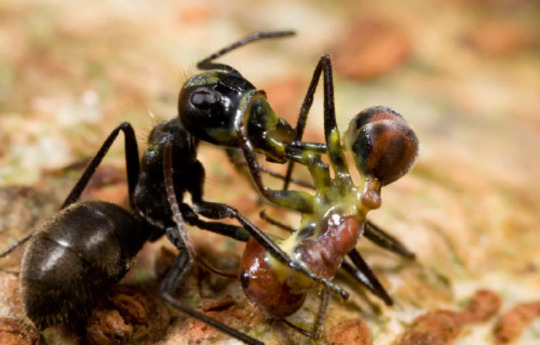
22 notes
·
View notes
Text

CONTENDER 1: TSETSE FLY!
The tsetse fly, Glossina spp. is a genus of obligate parasites. They are most known for spreading African sleeping sickness, but interestingly, they also give live birth and produce a milk-like fluid in their abdomens. Females develop one egg at a time internally, nourishing it in her uterus before it emerges.
CONTENDER 2: BAPHOMET MOTH!
The baphomet moth, Creatonotos gangis, is a moth native to southeastern Asia and Australia. Its common name comes from its inflated, large mating glands, which give its silhouette a ghastly, almost goatlike appearance. These mating glands are used by males to attract females. Interestingly, the chemicals secreted by these glands are derived from insect repellents in plants.

30 notes
·
View notes
Text
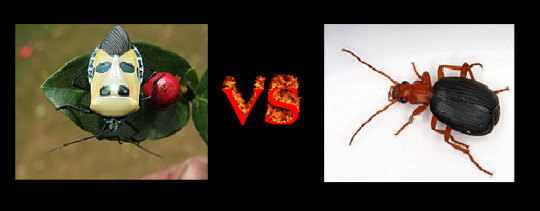
CONTENDER 1: MAN-FACED STINKBUG!
The man-faced stinkbug (Catacanthus incarnatus) is a member of the family Pentatomidae, also known as the stink bugs or shield bugs. When disturbed, bugs in this family can release a foul odor to deter predators, often containing alkane or aldehyde compounds. The brightly-colored red or yellow markings on the man-faced stinkbug, in addition to looking something like a human face, are an example of aposematic coloration, warning of their noxious emissions.
CONTENDER 2: BOMBARDIER BEETLE!
Bombardier beetles (family Carabidae) are named after their primary defense tactic. The abdomens of bombardier beetles feature a glandular sac at the tip, which secretes hydroquinone. When the beetle is disturbed, it releases both the hydroquinone and hydrogen peroxide into a thick-walled chamber called a vestibule, where a chemical reaction produces intense heat and free oxygen, resulting in a minor explosion that sprays the boiling liquid at the attacker.
16 notes
·
View notes
Text
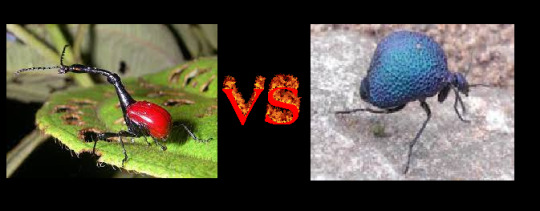
CONTENDER 1: GIRAFFE WEEVIL!
The giraffe weevil (Trachelophorus giraffa, family Attelabidae) is a species of weevil endemic to Southern Africa, Southeast Asia, and India. Its long neck is sexually dimorphic, and the neck of the male can be up to 2-3x longer than that of the female. The male giraffe beetle uses its neck to fight other males, and the female uses it to roll leaves into tubes, into which she then lays her eggs.
CONTENDER 2: DESERT SPIDER BEETLE!
Native to the deserts of North and Central America, the desert spider beetle (genus Cysteodemus) is a member of the family Meloidae, also known as blister beetles. Individuals of this family are known for producing a caustic chemical known as cantharidin, which is secreted by males and given to females, who then spread it over their eggs for protection. The desert spider beetle is particularly known for its inflated elytra (wing coverings), which make its abdomen especially rounded and pronounced.
40 notes
·
View notes
Text

CONTENDER 1: SNAKEFLY!
Snakeflies (order Raphidioptera) experienced a diversity peak in the Cretaceous, and have since declined to only around 260 species worldwide. Snakeflies are holometabolous and go through a complete metamorphosis from larva to adult, and the larval stage (seen below) can last up to six years in extended cases. They are terrestrial carnivores and predate smaller arthropods, such as aphids. The most prominent feature of the snakefly is the elongated prothorax or "neck", which gives the group the long, sinuous appearance that has led to their name.
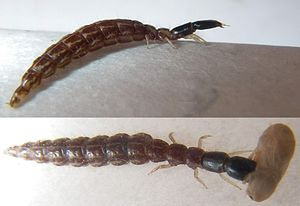
CONTENDER 2: PERIODICAL CICADA!
"Periodical cicada" is a term used to refer to any species within the genus Magicicada (family Cicadidae), which contains the 13- and 17-year cicada species of North America. The periodical cicada spends a large portion of its life (13 or 17 years, depending on population/brood) underground as a nymph, before emerging in massive numbers in spring and early summer to mate and, subsequently, die. During that time, there may be millions of individuals, with a collective biomass of up to or over half a metric ton. Male cicadas use auditory organs called tymbals (seen below) to call to mates, and the combined sound can be between 90 and 100 decibels.

22 notes
·
View notes
Text

CONTENDER 1: STALK-EYED FLY!
There are around 150 species of stalk-eyed fly (family Diopsidae), found mostly in Southeastern Asia and Southern Africa. These fungus- and bacteria-feeding insects are most obviously characterized by their prominent eye stalks, which are present in both sexes but longer on the males. The eye stalks are the basis of the stalk-eyed fly's sexual selection, and males in competition will face off against each other and spread their front legs, possibly to emphasize or gauge eye span lengths. The eyes begin elongating shortly after the fly emerges from its pupa, and do so asymmetrically (seen below). In addition to its eyes, the stalk-eyed fly's antennae are located on its eye stalks.

CONTENDER 2: RED-NOSED LANTERNFLY!
Native to South and Southeast Asia, the red-nosed lanternfly (Pyrops karenius, family Fulgoridae) is a fairly long type of planthopper, though much of that length is due to the size of the anterior lantern, a specialized tube-like mouthpart that resembles a snout and is used for sap-feeding. Lanternflies gained their name through the myth that this protrusion lit up at night, and while this is not true, the red-nosed lanternfly's lantern is brightly colored and particularly prominent. Though the name may conjure images of its more distant cousin the spotted lanternfly, the red-nosed lanternfly is not known to be invasive in North America.
22 notes
·
View notes
Photo


Rainbow Katydids by Arthur Anker and Bernard DuPont
20K notes
·
View notes
Text
Ms Baeus undertakes the long, dangerous journey across a blade of grass
#Nugget
4/15/23. N. Florida




590 notes
·
View notes
Text
*taptaptaptaptaptaptap* 🥹
I didn't get to go on a walk this afternoon, but I did go in the back yard and find a Barely-Sentient Dot, Ms. Baeus. Enjoy a small video of her running across a page full of 12-pt periods. 🤎 Yep, that's a wasp.
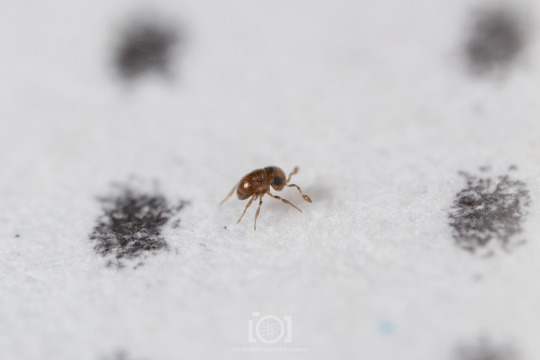
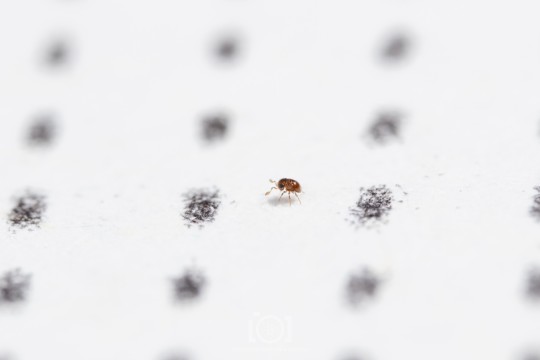
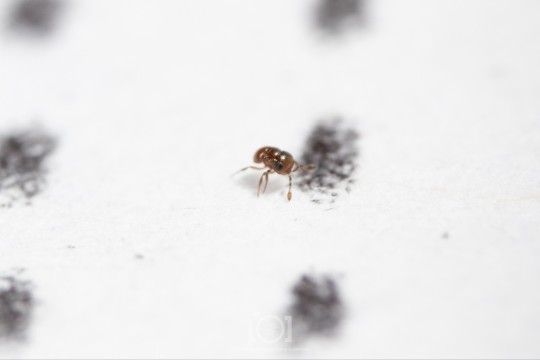
4K notes
·
View notes
Text
PLEASE READ ALL INFORMATION BEFORE VOTING! You might have a pre-existing idea of which insect is weirdest, but that might change after you learn a little more about them!
0 notes
Text

CONTENDER 1: BRAZILIAN TREEHOPPER!
Bocydium globulare is a species of treehopper native to South America. They feed on leaf matter and sap. The round, bulbous appendages on top of their thoraxes have a purpose yet to be determined by scientists, but it's theorized that they're used in predator deterrence.
CONTENDER 2: GIANT WETA!
Giant wētā, Deinacrida spp., are a group of insects endemic to New Zealand. These giant, flightless crickets are some of the heaviest insects in the world, with some known organisms weighing more than seventy grams, more than an average sparrow. The genus name Deinacrida means "terrible grasshopper."
18 notes
·
View notes
Text

CONTENDER 1: BAEUS!
Baeus :3
CONTENDER 2: FAIRYFLY WASP!
Fairyfly wasps are tiny wasps of the family Mymaridae. These itsy bitsy creatures parasitize other insects' eggs and generally only live for a few days. Many of these insects are fewer than 1.0 mm long, and are distinguished by their fuzzy wings and club-shaped antennae.
18 notes
·
View notes
Text

CONTENDER 1: CRANEFLY!
Craneflies are flies in the family Tipulidae. Resembling and often mistaken for oversized mosquitos, these insects are harmless. Adults often do not have mouths or mouthparts, and those that do are generally nectar-drinkers. These flies are often seen missing their exceedingly delicate limbs; they only live for a few days as adults, so losses of legs and wings are not strongly felt.
CONTENDER 2: SUICIDE BOMBER ANT!
Colobopsis saundersi, also called the suicide bomber ant, is a species of ant native to Malaysia. These aggressive, territorial ants are known to grab onto invaders and explode their bodies fatally, dousing the enemy in sticky, gluelike formic acid. The mechanism by which these ants detonate involves a rupturing of their internal membranes.

22 notes
·
View notes
Text

CONTENDER 1: TSETSE FLY!
The tsetse fly, Glossina spp. is a genus of obligate parasites. They are most known for spreading African sleeping sickness, but interestingly, they also give live birth and produce a milk-like fluid in their abdomens. Females develop one egg at a time internally, nourishing it in her uterus before it emerges.
CONTENDER 2: BAPHOMET MOTH!
The baphomet moth, Creatonotos gangis, is a moth native to southeastern Asia and Australia. Its common name comes from its inflated, large mating glands, which give its silhouette a ghastly, almost goatlike appearance. These mating glands are used by males to attract females. Interestingly, the chemicals secreted by these glands are derived from insect repellents in plants.

30 notes
·
View notes
Text

CONTENDER 1: MAN-FACED STINKBUG!
The man-faced stinkbug (Catacanthus incarnatus) is a member of the family Pentatomidae, also known as the stink bugs or shield bugs. When disturbed, bugs in this family can release a foul odor to deter predators, often containing alkane or aldehyde compounds. The brightly-colored red or yellow markings on the man-faced stinkbug, in addition to looking something like a human face, are an example of aposematic coloration, warning of their noxious emissions.
CONTENDER 2: BOMBARDIER BEETLE!
Bombardier beetles (family Carabidae) are named after their primary defense tactic. The abdomens of bombardier beetles feature a glandular sac at the tip, which secretes hydroquinone. When the beetle is disturbed, it releases both the hydroquinone and hydrogen peroxide into a thick-walled chamber called a vestibule, where a chemical reaction produces intense heat and free oxygen, resulting in a minor explosion that sprays the boiling liquid at the attacker.
16 notes
·
View notes